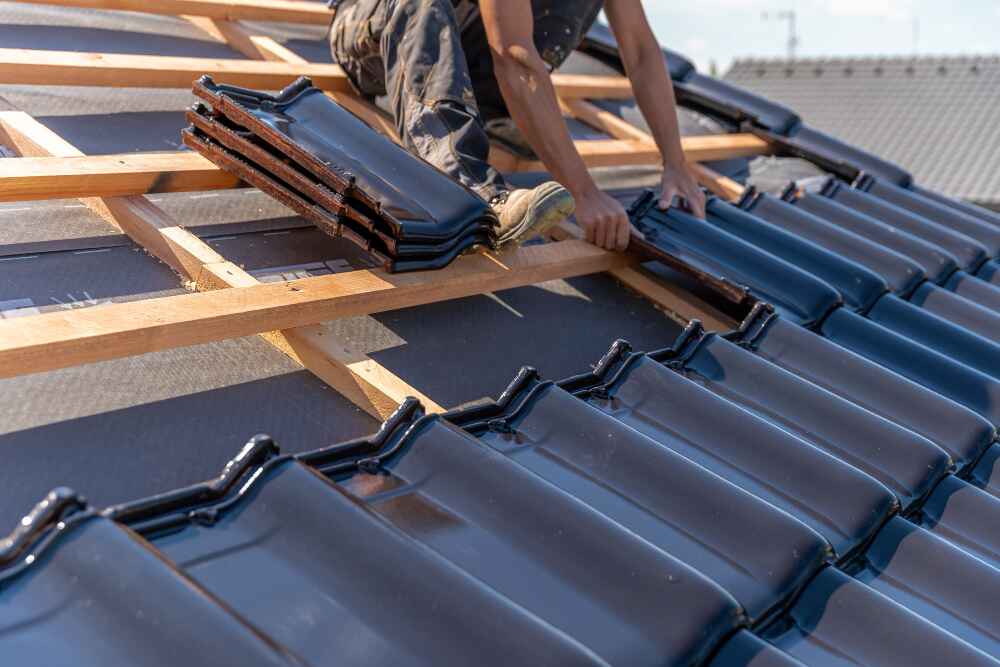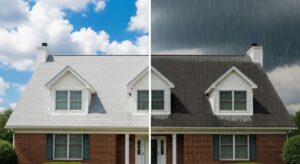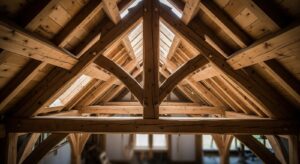There’s something almost magical about watching a master craftsman install slate tiles on a roof. Each piece of natural stone is carefully selected, positioned, and secured with the precision of an artist creating a masterpiece. But what happens when that masterpiece begins to show its age? When should you consider slate roof replacement versus slate roof restoration? And how do you ensure your investment in this premium roofing material pays off for generations to come?
If you’re facing the daunting decision of slate roof replacement, you’re not alone. Thousands of homeowners with aging slate roofs grapple with this choice every year. The good news? With proper planning, quality materials, and skilled installation, a slate roof replacement can transform your home while providing protection that lasts well over a century.
In this comprehensive guide, we’ll explore everything you need to know about slate roof replacement, from identifying when it’s time to replace your slate roof to selecting the right contractors and materials. Whether you’re dealing with a few problematic areas or considering a complete slate roof restoration, this guide will help you make informed decisions that protect both your home and your investment.
Understanding Slate Roofing: Why Replacement Matters
Slate roofing has been prized for centuries for its durability, natural beauty, and fire resistance. Unlike other roofing materials that require frequent replacement, a properly installed slate roof can last 100-200 years with minimal maintenance. However, even the most durable slate eventually reaches a point where slate roof replacement becomes necessary.
The Anatomy of Slate Roof Deterioration
Understanding how slate roofs age helps you make informed decisions about replacement timing:
Natural Weathering Process:
- Freeze-thaw cycles gradually weaken slate structure
- Acid rain and pollution can accelerate deterioration
- UV exposure causes subtle color changes over decades
- Natural settling of the home affects slate alignment
Common Failure Points:
- Fastener corrosion leads to loose or missing slates
- Flashing deterioration allows water infiltration
- Underlayment breakdown compromises water resistance
- Structural settling creates alignment issues
When Slate Roof Restoration Isn’t Enough
While slate roof restoration can address many issues, certain conditions require complete slate roof replacement:
Structural Concerns:
- Widespread slate cracking or delamination
- Severe fastener failure throughout the roof
- Inadequate or failed roof decking
- Compromised structural support systems
Performance Issues:
- Persistent leaks despite multiple slate repair attempts
- Inadequate insulation or ventilation systems
- Energy efficiency concerns with older installation methods
- Building code compliance requirements
Signs Your Slate Roof Needs Replacement
Recognizing the warning signs early can help you plan for slate roof replacement before emergencies arise.
Visual Indicators from Ground Level
Obvious Red Flags:
- Multiple missing or visibly cracked slates
- Sagging roof sections or uneven lines
- Excessive moss or vegetation growth
- Visible gaps or misaligned slate tiles
- Gutters filled with slate fragments
Subtle Warning Signs:
- Gradual color changes or fading
- Slight unevenness in roof lines
- Increased debris in gutters after storms
- White staining or efflorescence on slate surfaces
Interior Warning Signs
Don’t ignore these indoor indicators of slate roof problems:
Water Damage Evidence:
- Ceiling stains or discoloration
- Musty odors in attic spaces
- Peeling paint or wallpaper
- Visible mold or mildew growth
- Increased humidity levels indoors
Structural Indicators:
- Cracks in interior walls or ceilings
- Doors or windows that stick or won’t close properly
- Uneven floors in upper levels
- Visible sagging in ceiling areas
Professional Assessment Criteria
A qualified roofing contractor evaluates several factors when determining slate roof replacement needs:
Technical Evaluation Points:
- Remaining slate thickness and integrity
- Fastener condition and holding power
- Underlayment and decking condition
- Flashing and waterproofing effectiveness
- Overall system performance and longevity
Types of Slate Roof Replacement Options
Not all slate roof replacement projects are created equal. Understanding your options helps you choose the best approach for your specific situation and budget.
Complete Slate Roof Replacement
This comprehensive approach involves removing all existing materials and installing a completely new slate roof system.
When Complete Replacement is Necessary:
- Structural damage to roof decking
- Widespread slate deterioration
- Desire to upgrade to modern installation methods
- Building code compliance requirements
- Energy efficiency improvements
Complete Replacement Process:
- Careful removal and disposal of existing slate
- Inspection and repair of roof decking
- Installation of modern underlayment systems
- Proper flashing installation and waterproofing
- Professional slate installation with quality fasteners
- Final inspection and quality assurance testing
Advantages:
- Longest-lasting solution (100+ years)
- Opportunity to upgrade insulation and ventilation
- Modern installation techniques and materials
- Comprehensive warranty coverage
- Improved energy efficiency
Partial Slate Roof Replacement
Sometimes only sections of your slate roof require replacement while other areas remain in good condition.
Ideal Scenarios for Partial Replacement:
- Storm damage to specific roof areas
- Localized deterioration patterns
- Recent repairs to portions of the roof
- Budget considerations requiring phased approach
Considerations for Partial Replacement:
- Matching existing slate can be challenging
- Different installation dates may affect long-term performance
- Warranty coverage may be limited to replaced sections
- Future replacement timing becomes more complex
Slate Roof Restoration vs. Replacement
Understanding the difference between restoration and replacement helps you make the right choice for your situation.
Slate Roof Restoration Includes:
- Replacing individual damaged slates
- Repairing or replacing flashing systems
- Addressing minor structural issues
- Cleaning and treating slate surfaces
- Improving ventilation and insulation
When Restoration is Sufficient:
- Majority of slates remain in good condition
- Structural elements are sound
- Issues are primarily cosmetic or limited
- Budget constraints require phased approach
When Replacement is Necessary:
- Widespread slate deterioration
- Structural concerns with roof system
- Repeated restoration attempts have failed
- Desire for long-term solution and warranty
Selecting Quality Slate Materials for Replacement
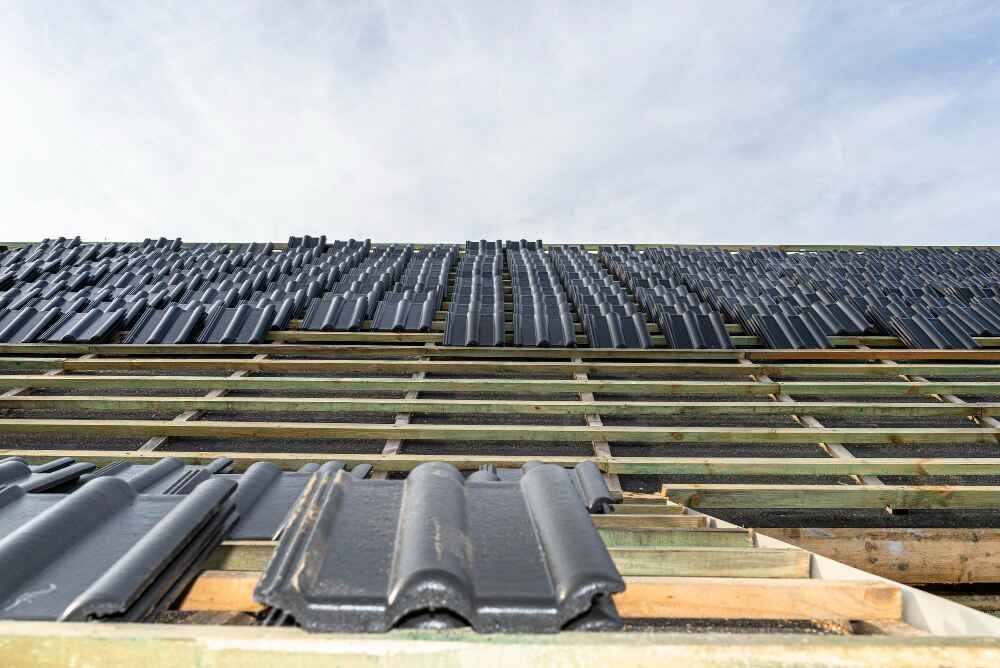
The success of your slate roof replacement depends heavily on material selection. Not all slate is created equal, and choosing the right type for your climate and aesthetic preferences is crucial.
Types of Slate for Replacement Projects
Welsh Slate:
- Premium quality with exceptional durability
- Distinctive blue-gray color with subtle variations
- Excellent weather resistance
- Higher cost but superior longevity
- Ideal for luxury homes and historic restorations
Vermont Slate:
- Excellent North American option
- Available in various colors including green, red, and purple
- Good durability and weather resistance
- More readily available than imported options
- Excellent value for quality ratio
Spanish Slate:
- Cost-effective option for budget-conscious projects
- Distinctive reddish-brown coloration
- Good performance in moderate climates
- Widely available through specialty suppliers
- Suitable for many residential applications
Synthetic Slate Alternatives:
- Lighter weight reduces structural requirements
- Consistent color and texture
- Lower cost than natural slate
- Easier installation and maintenance
- Various manufacturers offer different qualities
Quality Indicators for Slate Selection
Physical Properties to Evaluate:
- Uniform thickness and consistent dimensions
- Smooth, even surface without major imperfections
- Appropriate absorption rate for your climate
- Adequate strength for installation and longevity
- Compatibility with the existing architectural style
Supplier Considerations:
- Reputation and track record in the slate industry (National Slate Association guidelines)
- Quality control processes and standards
- Warranty coverage and support
- Technical expertise and installation guidance
- Logistics and delivery capabilities
The Slate Roof Replacement Process: What to Expect
Understanding the replacement process helps you prepare for the project and ensure quality results.
Pre-Installation Phase
Initial Assessment and Planning:
- Comprehensive roof inspection and documentation
- Structural evaluation of existing roof system
- Material selection and ordering
- Permit acquisition and regulatory compliance
- Weather planning and project scheduling
Site Preparation:
- Protection of landscaping and property
- Setup of safety equipment and access systems
- Delivery and staging of materials
- Coordination with utility companies if needed
- Establishment of debris removal procedures
Removal and Preparation
Careful Slate Removal: Professional slate removal requires specialized techniques to prevent damage to underlying structures:
Systematic Removal Process:
- Work from top to bottom in controlled sections
- Use appropriate tools to avoid deck damage
- Sort and evaluate existing slate for potential reuse
- Identify and address any structural issues discovered
Deck Inspection and Repair:
- Evaluate existing roof decking condition
- Replace damaged or deteriorated sections
- Ensure proper spacing and attachment
- Address any structural concerns before proceeding
Underlayment Installation:
- Install high-quality synthetic underlayment
- Ensure proper overlap and sealing
- Pay special attention to valleys and penetrations
- Consider ice and water shield in appropriate climates
Professional Installation Techniques
Proper Slate Installation Methods:
- Correct fastener selection and placement
- Appropriate overlap and exposure calculations
- Proper alignment and spacing techniques
- Attention to detail around roof penetrations
- Quality control throughout installation process
Flashing and Waterproofing:
- Installation of step flashing at wall intersections
- Proper valley flashing techniques
- Chimney and vent penetration sealing
- Ridge and hip detail installation
- Gutter and downspout integration
Quality Control and Final Inspection
Installation Quality Checks:
- Verify proper slate alignment and spacing
- Check fastener placement and security
- Inspect flashing and waterproofing details
- Test drainage and water flow patterns
- Document installation for warranty purposes
Final Project Completion:
- Complete cleanup and debris removal
- Final walkthrough with homeowner
- Warranty documentation and care instructions
- Maintenance recommendations and scheduling
- Follow-up inspection scheduling
Slate Repair vs. Replacement: Making the Right Choice
Deciding between slate repair and full replacement requires careful consideration of multiple factors.
When Slate Repair is Sufficient
Isolated Damage Scenarios:
- Storm damage affecting limited areas
- Individual slate failures due to age
- Minor flashing or fastener issues
- Localized leak problems
- Cosmetic concerns in visible areas
Repair Techniques for Common Issues:
- Individual Slate Replacement: Carefully remove damaged slate and install matching replacement
- Fixing Slate Roof Fasteners: Replace corroded or failed fasteners with appropriate materials
- Flashing Repairs: Address localized flashing failures without full system replacement
- Minor Structural Repairs: Fix small areas of damaged decking or support structures
Cost-Benefit Analysis: Repair vs. Replacement
Factors Favoring Repair:
- Limited scope of damage
- Recent installation or previous repairs
- Budget constraints requiring immediate solution
- Availability of matching slate materials
- Structural elements in good condition
Factors Favoring Replacement:
- Widespread deterioration throughout roof
- Repeated repair attempts with limited success
- Desire for long-term solution and warranty
- Opportunity to upgrade system performance
- Building code compliance requirements
Professional Assessment for Decision Making
Evaluation Criteria Used by Professionals:
- Overall roof condition and remaining lifespan
- Structural integrity of supporting systems
- Cost-effectiveness of repair versus replacement
- Availability of matching materials
- Homeowner’s long-term plans and budget
Working with Slate Roof Replacement Contractors
Selecting the right contractor is crucial for successful slate roof replacement. Not all roofing contractors have the specialized skills required for quality slate work.
Qualifications to Look For
Essential Contractor Credentials:
- Specialized slate roofing experience (minimum 5 years)
- Proper licensing and insurance coverage
- Manufacturer certifications for slate products
- Strong local reputation and references
- Membership in professional roofing associations
Questions to Ask Potential Contractors:
- How many slate roof replacement projects have you completed?
- Can you provide references from recent slate projects?
- What type of warranty do you offer on slate installation?
- Do you have experience with my specific type of slate?
- How do you handle unexpected issues during installation?
Red Flags to Avoid
Warning Signs of Unqualified Contractors:
- Door-to-door solicitation immediately after storms
- Requests for full payment before work begins
- Lack of proper licensing or insurance
- Unusually low bids compared to other estimates
- No references or portfolio of previous work
- Pressure tactics or urgent decision requirements
Contract and Warranty Considerations
Essential Contract Elements:
- Detailed scope of work and materials specifications
- Clear timeline and milestone schedules
- Payment schedule tied to project completion
- Warranty terms for both materials and workmanship
- Procedures for handling unexpected issues
- Cleanup and disposal responsibilities
Warranty Coverage Expectations:
- Minimum 10-year workmanship warranty
- Material warranties from manufacturers
- Clear procedures for warranty claims
- Coverage for both materials and labor
- Transferability to future homeowners
Cost Factors for Slate Roof Replacement
Understanding the various cost factors helps you budget appropriately for your slate roof replacement project.
Material Costs
Slate Material Pricing:
- Welsh Slate: $8-15 per square foot
- Vermont Slate: $6-12 per square foot
- Spanish Slate: $4-8 per square foot
- Synthetic Slate: $3-7 per square foot
Additional Material Costs:
- Underlayment and ice shield: $1-3 per square foot
- Flashing and trim materials: $2-5 per linear foot
- Fasteners and installation hardware: $0.50-1.50 per square foot
- Ridge and hip materials: $5-15 per linear foot
Labor and Installation Costs
Professional Installation Pricing:
- Basic installation: $5-10 per square foot
- Complex roof configurations: $10-15 per square foot
- Historic restoration work: $15-25 per square foot
- Removal and disposal: $2-4 per square foot
Factors Affecting Labor Costs:
- Roof complexity and accessibility
- Regional labor rates and availability
- Seasonal demand fluctuations
- Permit and inspection requirements
- Waste disposal and cleanup needs
Additional Project Costs
Potential Additional Expenses:
- Structural repairs or reinforcement: $1,000-5,000
- Permit and inspection fees: $200-800
- Temporary weatherization: $500-2,000
- Landscaping protection: $200-500
- Specialty equipment rental: $500-1,500
Financing Options for Slate Roof Replacement
Available Financing Solutions:
- Home improvement loans with competitive rates
- Home equity lines of credit for larger projects
- Manufacturer financing programs
- Insurance claims for storm damage
- Energy efficiency rebates and incentives
Maintaining Your New Slate Roof
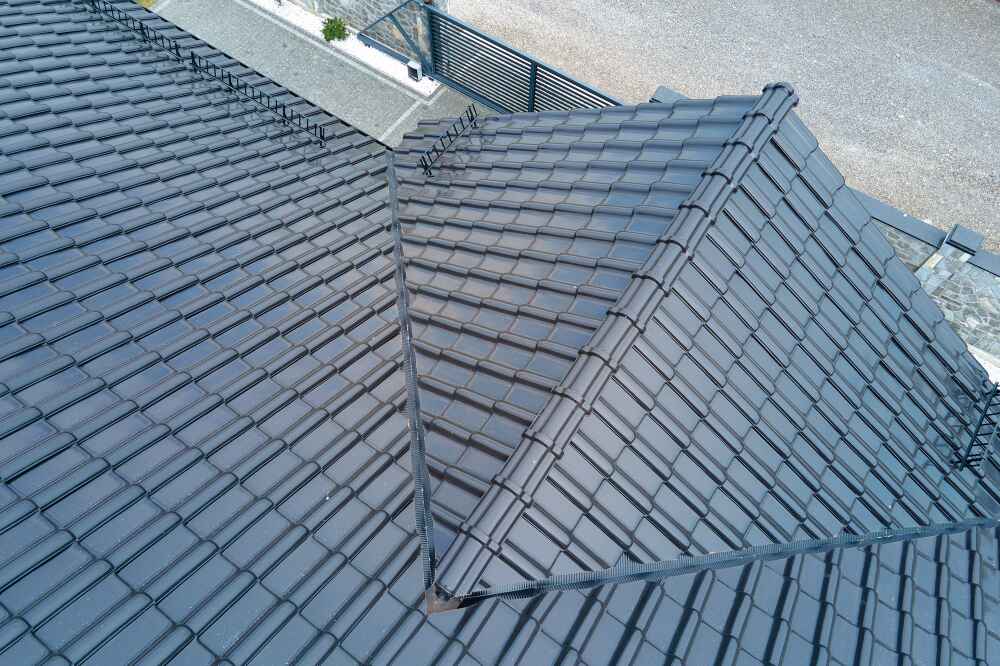
Proper maintenance ensures your slate roof replacement investment provides decades of reliable service.
Essential Maintenance Practices
Regular Inspection Schedule:
- Bi-annual visual inspections from ground level
- Professional inspections every 3-5 years
- Post-storm damage assessments
- Seasonal maintenance task completion
- Documentation of all maintenance activities
Preventive Maintenance Tasks:
- Gutter cleaning and drainage maintenance
- Removal of debris and organic growth
- Flashing inspection and minor repairs
- Ventilation system maintenance
- Tree trimming and vegetation management
Long-term Care Strategies
Protecting Your Investment:
- Establish relationships with qualified slate repair specialists
- Maintain documentation of installation and warranties
- Budget for periodic maintenance and minor repairs
- Monitor performance and address issues promptly
- Consider preventive treatments for specific climates
Integration with Other Roofing Systems
Modern homes often feature complex roofing systems that require coordinated maintenance. Learn more in our types of roofing materials maintenance guide.
Complementary Services:
- Concrete tile roof maintenance for mixed roofing systems
- Metal roof maintenance for flashing and trim elements
- Roof preservation tips for overall system longevity
Environmental and Sustainability Considerations
Slate roof replacement offers significant environmental benefits compared to other roofing materials.
Sustainability Benefits of Slate
Environmental Advantages:
- Natural material with minimal processing requirements
- An extremely long lifespan reduces replacement frequency
- Recyclable and reusable at end of service life
- Excellent insulation properties improve energy efficiency
- Low maintenance requirements reduce chemical usage
Energy Efficiency Improvements:
- Natural thermal mass helps regulate interior temperatures
- Proper ventilation installation reduces cooling costs and aligns with Energy Star roofing materials
- Reflective properties reduce heat island effects
- Integration with modern insulation systems
- Compatibility with renewable energy systems
Responsible Disposal and Recycling
Sustainable Disposal Practices:
- Salvage undamaged slate for reuse in other projects
- Recycle slate materials for landscaping applications
- Proper disposal of damaged materials
- Minimize waste through careful planning
- Work with contractors committed to sustainable practices
Regional Considerations for Slate Roof Replacement
Different climates and regional conditions affect slate roof replacement approaches and material selection.
Climate-Specific Considerations
Cold Climate Adaptations:
- Enhanced ice and water shield installation
- Proper ventilation to prevent ice dams
- Appropriate fastener selection for freeze-thaw cycles
- Consideration of snow load requirements
- Seasonal installation timing planning
Hot Climate Modifications:
- Light-colored slate selection for heat reflection
- Enhanced ventilation systems for cooling
- UV-resistant underlayment materials
- Thermal expansion accommodation
- Cooling cost reduction strategies
Coastal Environment Challenges:
- Corrosion-resistant fasteners and flashing
- Enhanced weatherproofing for storm resistance
- Salt spray protection measures
- Wind uplift resistance requirements
- Hurricane and severe weather preparations
Historic District Requirements
Preservation Considerations:
- Compliance with historic preservation guidelines
- Matching original slate types and colors
- Approved installation methods and materials
- Documentation requirements for permits
- Coordination with preservation authorities
Technology and Innovation in Slate Roofing
Modern slate roof replacement benefits from technological advances and innovative installation techniques.
Advanced Installation Techniques
Modern Installation Improvements:
- Synthetic underlayment with superior performance
- Improved fastener technology and materials
- Enhanced flashing systems and techniques
- Better ventilation and insulation integration
- Quality control and testing procedures
Digital Tools and Planning:
- Drone inspection and documentation
- 3D modeling for complex installations
- Weather monitoring and timing optimization
- Project management and tracking systems
- Quality assurance documentation
Future-Proofing Your Investment
Preparing for Future Needs:
- Compatible mounting systems for solar panels
- Infrastructure for smart home technology
- Accommodation for future maintenance access
- Flexibility for building modifications
- Integration with evolving building codes
Frequently Asked Questions About Slate Roof Replacement
How long does slate roof replacement typically take?
A typical slate roof replacement project takes 1-3 weeks, depending on roof size, complexity, and weather conditions. Simple rectangular roofs may be completed in 5-7 days, while complex configurations with multiple dormers, chimneys, and architectural features can take 2-3 weeks or more. Weather delays are common and should be factored into your timeline expectations.
Can I install solar panels on my new slate roof?
Yes, solar panels can be installed on slate roofs with proper mounting systems designed specifically for slate. However, this requires careful planning during the slate roof replacement process to ensure mounting points are properly reinforced and waterproofed. Discuss solar panel plans with your contractor before installation begins.
How do I know if my slate roof replacement contractor is qualified?
Look for contractors with specific slate roofing experience, proper licensing and insurance, manufacturer certifications, and a portfolio of completed slate projects. Ask for references from recent customers and verify their credentials with licensing boards. Avoid contractors who solicit door-to-door or pressure you for immediate decisions.
What’s the difference between slate roof replacement and slate roof restoration?
Slate roof replacement involves removing all existing materials and installing a completely new roof system. Slate roof restoration focuses on repairing and refurbishing existing slate while preserving the original roof structure. Replacement is necessary when structural issues exist or widespread slate deterioration has occurred.
How much does slate roof replacement cost compared to other roofing materials?
Slate roof replacement typically costs $15-30 per square foot installed, significantly more than asphalt shingles ($3-8 per square foot) but comparable to premium materials like copper or clay tiles. However, slate’s 100+ year lifespan makes it cost-effective over time. The higher upfront investment is offset by minimal maintenance requirements and exceptional durability.
Can I match new slate with my existing roof for partial replacement?
Matching existing slate can be challenging due to weathering, discontinued quarries, and natural variations in slate. Professional contractors can often find acceptable matches, but perfect matches are rare. This is one reason why complete slate roof replacement is often preferred over partial repairs when extensive work is needed.
What maintenance will my new slate roof require?
New slate roofs require minimal maintenance compared to other roofing materials. Annual inspections, periodic gutter cleaning, and prompt attention to any damaged slates are typically sufficient. Professional inspections every 3-5 years help identify minor issues before they become major problems. Unlike how to clean a shingle roof, slate rarely requires cleaning.
How do I prepare my home for slate roof replacement?
Prepare by removing vehicles from driveways, protecting landscaping with tarps, securing loose outdoor items, and arranging alternative accommodations if necessary. Interior preparation includes moving valuables from upper floors and covering furniture in case of dust. Discuss specific preparation requirements with your contractor before work begins.
What warranty should I expect on slate roof replacement?
Quality slate roof replacement should include a minimum 10-year workmanship warranty from the contractor and material warranties from slate manufacturers. Some premium installations offer extended warranties up to 20 years. Ensure warranty terms cover both materials and labor, and understand the procedures for warranty claims.
Is slate roof replacement worth the investment?
For homes where slate is architecturally appropriate, replacement is often an excellent investment. Slate roofs add significant value to homes, provide exceptional durability, and require minimal maintenance over their lifespan. The high upfront cost is typically recovered through increased home value and reduced long-term roofing expenses.
Conclusion: Your Slate Roof Replacement Journey Starts Here
Slate roof replacement represents more than just a roofing project – it’s an investment in your home’s future, its architectural integrity, and your family’s protection for generations to come. Throughout this comprehensive guide, we’ve explored every aspect of the replacement process, from initial assessment through long-term maintenance, equipping you with the knowledge needed to make confident decisions about your slate roof replacement project.
The decision to replace your slate roof shouldn’t be taken lightly, but with proper planning, quality materials, and skilled installation, it becomes one of the most rewarding home improvement investments you can make. Your new slate roof will not only protect your home with unmatched durability but also enhance its beauty and value in ways that few other improvements can match.
Remember that successful slate roof replacement depends on three critical factors: choosing quality materials appropriate for your climate and aesthetic preferences, working with qualified contractors who specialize in slate installation, and committing to proper maintenance throughout the roof’s lifespan. Each of these elements plays a vital role in ensuring your investment provides optimal performance and longevity.
The information in this guide provides a solid foundation for your slate roof replacement journey, but every project is unique. Your specific circumstances, from architectural requirements to budget considerations, will influence the best approach for your situation. Don’t hesitate to consult with multiple qualified contractors to explore your options and develop a replacement plan that meets your needs and expectations.
Most importantly, remember that slate roof replacement is a long-term investment that will serve your family for decades. By taking the time to make informed decisions now, you’re ensuring that your home remains protected and beautiful for generations to come. The craftsmanship and attention to detail that goes into quality slate roof replacement creates not just a functional roof, but a lasting legacy of protection and beauty.
Ready to Begin Your Slate Roof Replacement Project?
Don’t let another season pass with an aging, potentially problematic slate roof over your head. Our team of certified slate roofing specialists is ready to help you transform your home with a beautiful, durable new slate roof that will protect your investment for generations.
We offer comprehensive slate roof replacement services, including:
- Free detailed assessments and replacement recommendations
- Expert material selection and sourcing
- Professional installation with extended warranties
- Full project management from start to finish
- Ongoing maintenance and support services
Why choose our slate roof replacement services?
- Over 15 years of specialized slate roofing experience
- Certified installers trained in traditional and modern techniques
- Comprehensive warranties on both materials and workmanship
- Proven track record with hundreds of satisfied customers
- Commitment to quality, safety, and customer satisfaction
Take the first step toward your new slate roof today. Contact us or complete our online assessment form to schedule your free consultation. Our slate roofing experts will evaluate your current roof, discuss your options, and provide a detailed estimate for your slate roof replacement project.
Don’t wait – your home deserves the ultimate protection and beauty that only a quality slate roof can provide. Call now and discover why discerning homeowners choose our slate roof replacement services for their most important investment.

